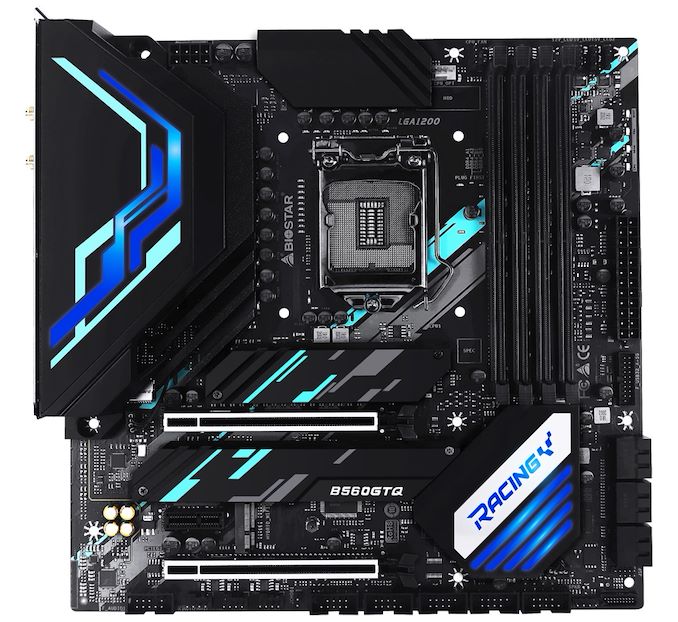The Intel B560 Motherboard Overview: 30+ Budget Models Starting from $75
by Gavin Bonshor on March 29, 2021 7:00 AM ESTBiostarB560GTQ
At the time of writing, Biostar has announced one B560 model designed for use with both Intel's 11th and 10th generation processors. The Biostar B560GTQ is a micro-ATX model with a very different aesthetic to everything else currently available on B560. It is using a primarily black PCB, with light blue and grey accented patterning. This stretches across the rear panel cover too and with the images we have available, it is hard to tell if the board includes integrated RGB LEDs or whether the chipset LEDs are blue only. Biostar is also advertising the B560GTQ as being equipped with a 12-phase power delivery, although the technical specifications of this are unknown.
Dominating the majority of the lower half of the board is the PCIe slots, with two full-length PCIe slots operating at PCIe 4.0 x16 and PCIe 3.0 x4, with a single PCIe 3.0 x1 slot sandwiched between them. For storage, the board includes one PCIe 4.0 x4 M.2 slot, with six SATA ports with support for RAID 0, 1, 5, and 10 arrays. Biostar also includes a Key-E M.2 slot for users to install its own Wi-Fi 6 wireless interface. In the top-right corner is four memory slots, which include support for up to DDR4-4000 and with a maximum capacity of 128 GB.
The rear panel includes one USB 3.2 G2x2 Type-C, five USB 3.2 G1 Type-A, and two USB 2.0 ports. Despite the rear panel image showing an antenna with Wi-Fi capability, the B560GTQ does not come with any wireless networking and will require users to use its own. Other connectivity includes one DisplayPort, one HDMI, and one DVI-D video output, with a PS/2 combo port for legacy peripherals. The B560GTQ has three 3.5 mm audio jacks which are powered by a Realtek ALC1220 HD audio codec and includea single Ethernet port driven by a Realtek RTL8125B 2.5 GbE controller.












59 Comments
View All Comments
Flunk - Monday, March 29, 2021 - link
Still limiting overclocking on mid-range boards even though the competition doesn't? Shame Intel, shame.shabby - Monday, March 29, 2021 - link
Do you really need to overclock though? Don't these cpus overclock themselves to 200w+ anyway?Linustechtips12#6900xt - Thursday, April 8, 2021 - link
just adjust the turbo limit time or enable MCE if you can, at least i think you can on b560 not sure and 2933/3000 mhz memory isnt the biggest deal eitherGreat_Scott - Monday, March 29, 2021 - link
The most recent crop of Intel CPUs 1) overclock on their own, and 2) don't have any thermal headroom.Really, getting a Non-K with a B-series motherboard and saving the money for (any) GPU is the better idea...
Martin84a - Monday, March 29, 2021 - link
Not that the work isn't appreciated, but I think you should just hire raisonjohn and call it a day. His work on a massive comparison spreadsheet for the AMD A, B and X motherboard is amazing, and light years ahead of anything I've seen.https://docs.google.com/spreadsheets/d/1wmsTYK9Z3-...
Tomatotech - Monday, March 29, 2021 - link
Decent stack range, but the vast majority have too many SATA and not enough m.2 and not enough USB type C ports. In the next few years there will be more and more type C equipment to plug in.Apart from that, most of them are good for final DDR4 boards as a final home for DDR4 RAM as DDR 5 starts coming in next year (or the year after).
With AMD’s reduction in CPU power the way seems open for some low power desktops to run entirely off USB-C with its power supply of up to 100w (delivered via DC so equal to a wall supply of maybe 130w AC as the transformer losses are in the wall wart not in the desktop PSU). That could mean smaller and cheaper desktops, powered straight from the monitor (if it has a USBC power supply) through the USBC video cable. Apple already has this setup though a few hoops need to be jumped through.
DanNeely - Monday, March 29, 2021 - link
Limited m.2 is mostly down to being mATX and budget. The smaller board size combined with m.2 being attached to the board itself doesn't leave much room for a 2nd slot unless you go with some sort of riser setup. And using a riser crashes into being budget products.USB-C rollout has been strangled by the decision to implement reversibility by adding an extra chip between the physical port and controller whose job is to swap the IO around instead of offloading that to the controller. Adding an extra dollar or two to the BOM per port has resulted in all the board makers deciding that not having multiple C ports is a good way to cut costs.
Lastly, mATX is going to be the last place we see SATA numbers shrink as long as Intel keep offering them on their chipsets. The plugs are dirt cheap, and unless you're building a maxed out full ATX board the chipset has more IO lanes than you can use. If numbers ever start dropping below what's offered in the chipset it'll either be on mITX boards that are badly space constrained or full ATX ones where the designers decide a few more PCIe lanes or USB3 ports would be more valuable.
TheinsanegamerN - Monday, March 29, 2021 - link
Plenty of AMD micro ATX boards have 2 slots, you just need some intelligent board design. Hell they can fit 2 on mini ITX without riser boards.Tomatotech - Tuesday, March 30, 2021 - link
Thanks Dan for the reply. I didn’t know that info about the USB-C extra chip causing issues. USB-IF strikes again!vailr - Monday, March 29, 2021 - link
Gigabyte also has the (full size ATX board) B460 HD3:https://www.gigabyte.com/Motherboard/B460-HD3-rev-...